So, as I mentioned this morning, we had a nice view of the annular eclipse today. I'd never seen one (nor have I ever seen a total eclipse, except on TV). Here are a few more pictures.
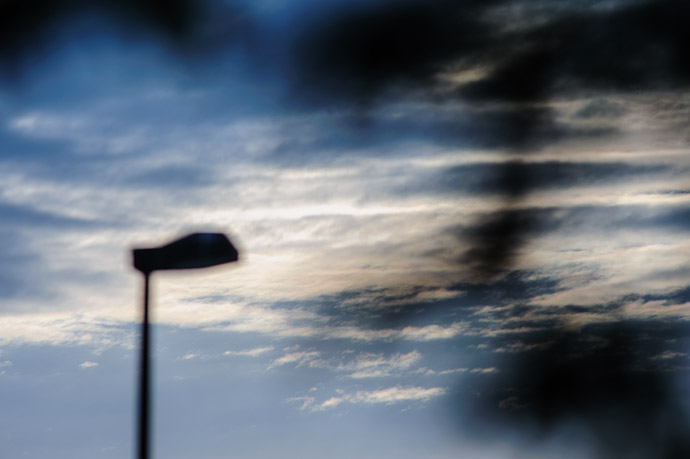
Nikon D700 + Nikkor 300mm f/2 + 1.4X TC @ 420mm — 1/1600 sec, f/5.6, ISO 200 — map & image data — nearby photos
First Contact
the moon is just starting to nip at the sun, somewhere behind those clouds
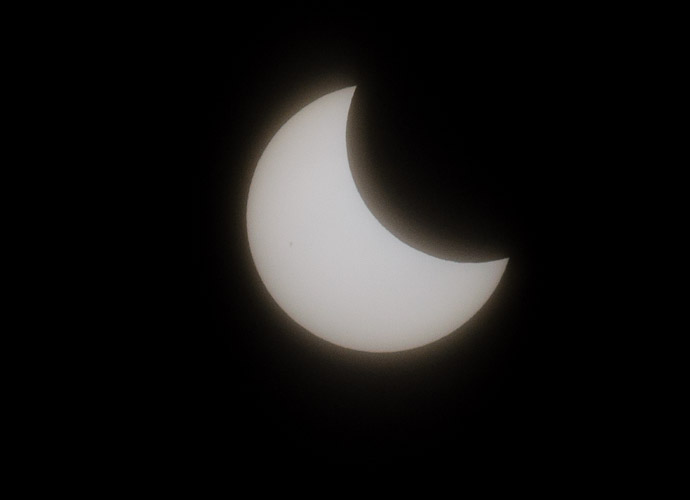
Nikon D700 + Nikkor 300mm f/2 + 1.4X TC @ 420mm cropped — 1/1600 sec, f/8, ISO 1000 — map & image data — nearby photos
35 Minutes To Go
quick snap from my veranda using a “D5” 1/100,000 filter
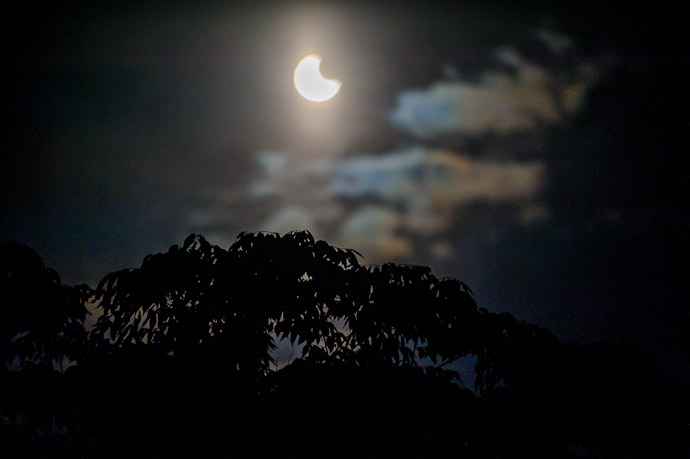
Nikon D700 + Nikkor 70-200mm f/2.8 @ 200mm — 1/1600 sec, f/2.8, ISO 1000 — map & image data — nearby photos
Slightly Wider View
That picture above illustrates in one way just how bright the sun is... I was using stacked filters to cut all but 1/3,200th of the light, leaving everything dark except the sun, which was still completely blown out. I wonder what the dynamic range is during one of these things, between the surface of the moon and the surface of the sun.
Notice the odd colors in the clouds? Sometimes you see that at night with the moon, and I suppose it's related to conditions in the upper atmosphere, but in any case you certainly couldn't see it in person because either you were using special sun goggles (which made everything but the sun completely black), or you were looking with the naked eye and anything that close to the sun was too bright to look at.
So the colors look odd, but we'd probably see them often during the day if our eyes could handle the brightness. (And speaking of handling the brightness, I've nudged up the variance of some of these shots in Lightroom, to exaggerate the colors for artistic effect.)
For the main event, I moved to near the main gate of the Heian Shrine, which has appeared many times on my blog (such as this shot from six and a half years ago). The sun was coming up behind it lengthwise, so I wondered whether the distinctive “oriental” shape of its silhouette would be interesting.
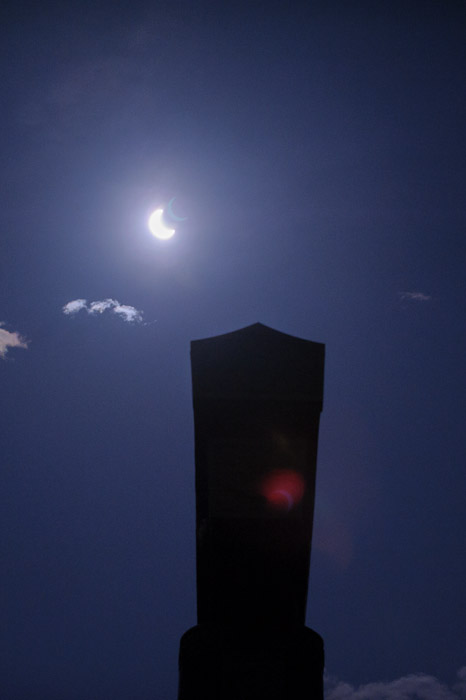
Nikon D700 + Nikkor 70-200mm f/2.8 @ 95mm — 1/125 sec, f/2.8, ISO 1000 — map & image data — nearby photos
Partial Eclipse
Main gate of the Heian Shrine, Kyoto Japan
11 minutes before annularity
The sun is completely blown out (no detail whatsoever), but I like how the reflections (refractions?) in the lens make for a green “ghost” of the eclipse just to the right of the sun, and an inverted red “ghost” down below.
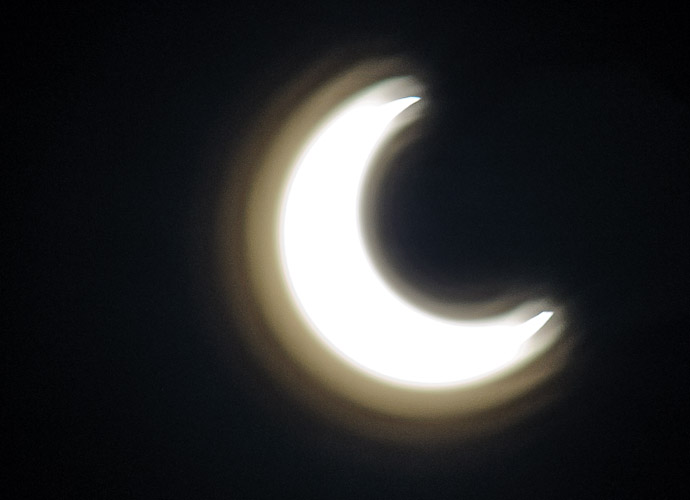
Nikon D700 + Nikkor 300mm f/2 + 1.4X TC @ 420mm cropped — 1/15 sec, f/8, ISO 1000 — map & image data — nearby photos
Oops
jiggly tripod reverberations become apparent during a misfire
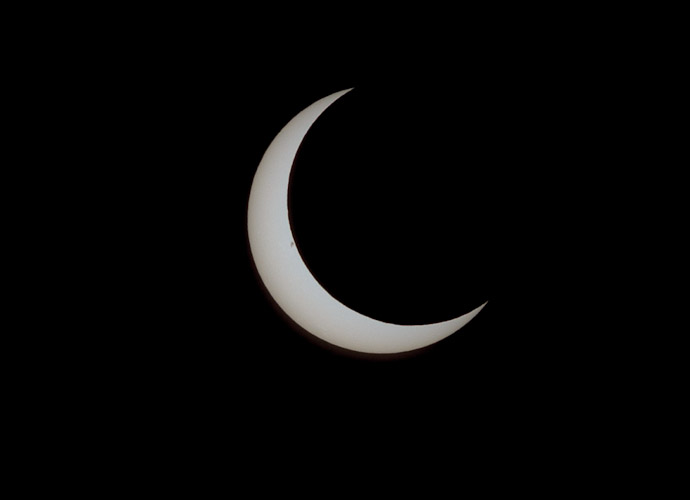
Nikon D700 + Nikkor 300mm f/2 + 1.4X TC @ 420mm cropped — 1/1600 sec, f/8, ISO 1000 — map & image data — nearby photos
That's Better
small sunspot about to get occluded
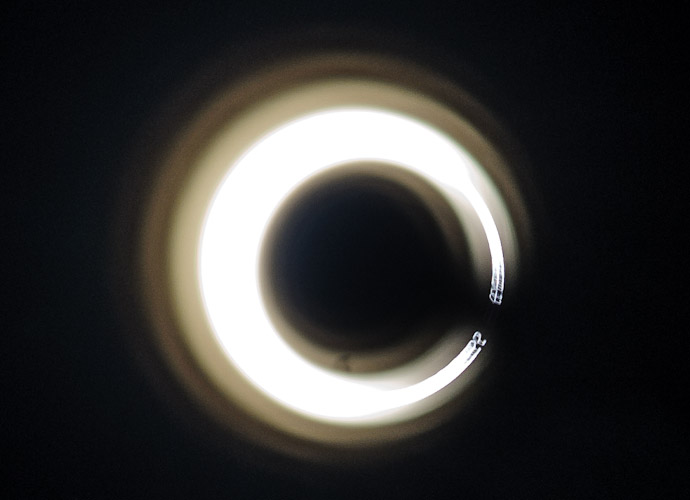
Nikon D700 + Nikkor 300mm f/2 + 1.4X TC @ 420mm cropped — 1/6 sec, f/8, ISO 1000 — map & image data — nearby photos
Another Oops
but a pretty one
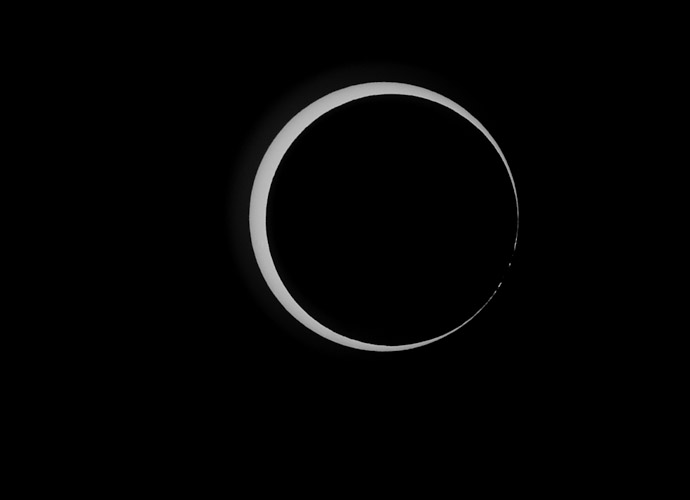
Nikon D700 + Nikkor 300mm f/2 + 1.4X TC @ 420mm cropped — 1/1600 sec, f/8, ISO 1000 — map & image data — nearby photos
Second Contact
you can see some sun peaking through some valleys
a few seconds after the nominal start of the full ring effect
I was surprised at how it didn't become dark. The sun was 94% covered (6% exposed) but you couldn't really tell... you certainly couldn't look at it with the naked eye without regretting it instantly, and if you didn't know something was going on, you might not even notice. With 94% hidden. The sun is really really really really bright.
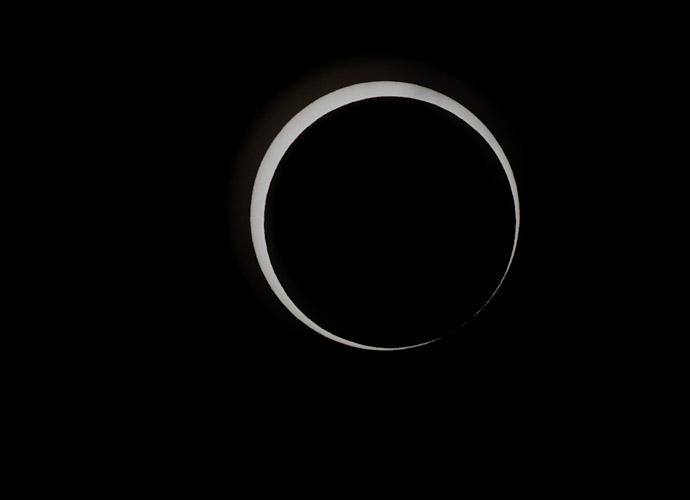
Nikon D700 + Nikkor 300mm f/2 + 1.4X TC @ 420mm cropped — 1/1600 sec, f/8, ISO 1000 — map & image data — nearby photos
Skirting The Edge
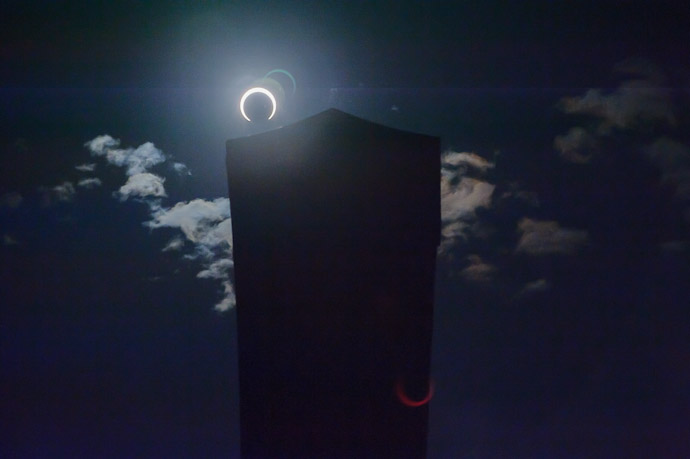
Nikon D700 + Nikkor 70-200mm f/2.8 @ 190mm — 1/160 sec, f/7.1, ISO 1000 — map & image data — nearby photos
Trying That Shot Again
I really couldn't see on the back of the camera whether anything was working out, so I just gave it a shot.
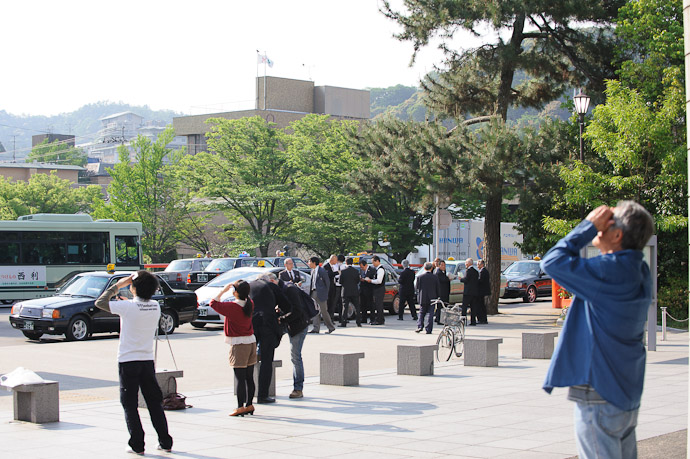
Nikon D700 + Nikkor 70-200mm f/2.8 @ 70mm — 1/320 sec, f/6.3, ISO 1000 — map & image data — nearby photos
Spectators
I heard that the park area along the length of the Kamo River (such as seen here and here) was absolutely packed. It sounds festive.
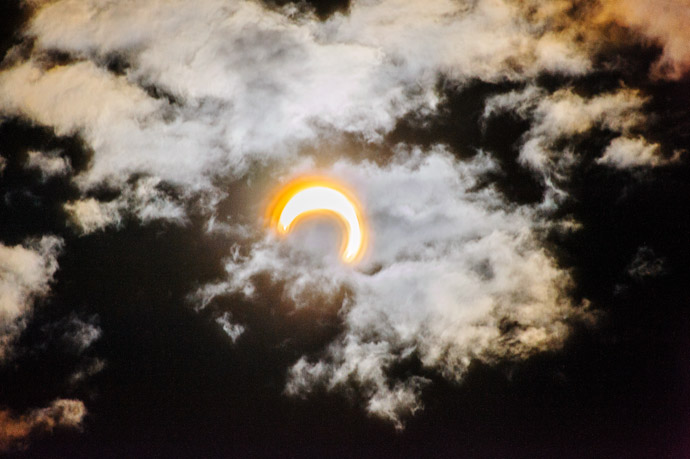
Nikon D700 + Nikkor 300mm f/2 + 1.4X TC @ 420mm cropped — 1/6 sec, f/8, ISO 1000 — map & image data — nearby photos
Note Quite Sure
but looks interesting
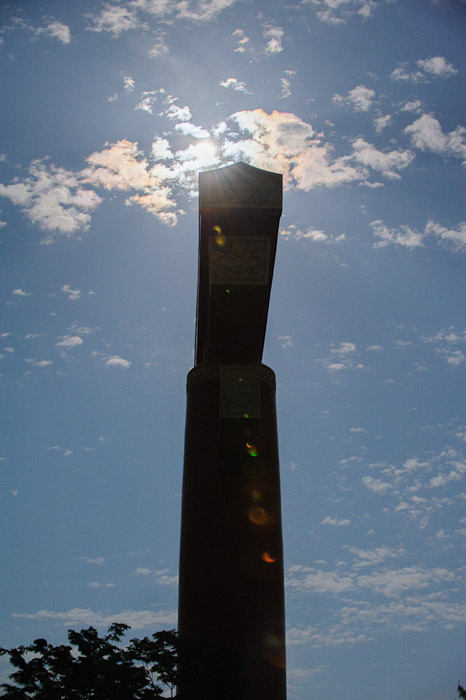
Nikon D700 + Nikkor 70-200mm f/2.8 @ 70mm — 1/160 sec, f/6.3, ISO 1000 — map & image data — nearby photos
Trying With Fewer Filters
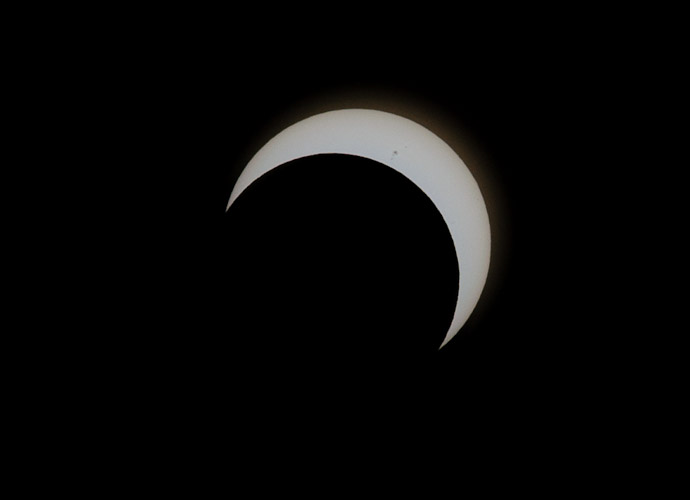
Nikon D700 + Nikkor 300mm f/2 + 1.4X TC @ 420mm cropped — 1/2500 sec, f/11, ISO 1000 — map & image data — nearby photos
Departing Moon
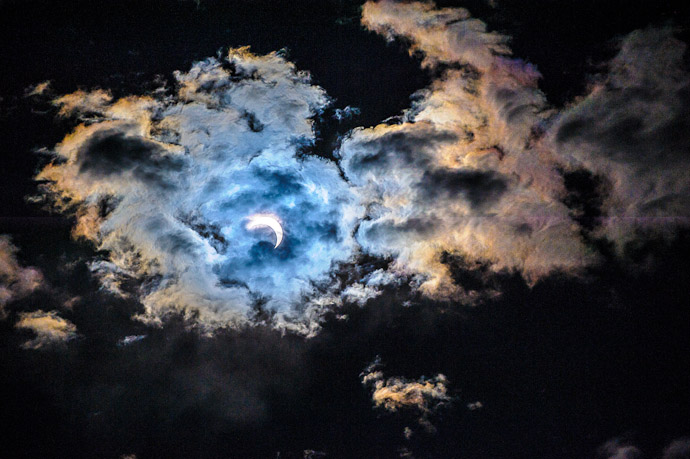
Nikon D700 + Nikkor 70-200mm f/2.8 @ 200mm — 1/250 sec, f/6.3, ISO 320 — map & image data — nearby photos
Those Crazy Colors
looking very moon-like
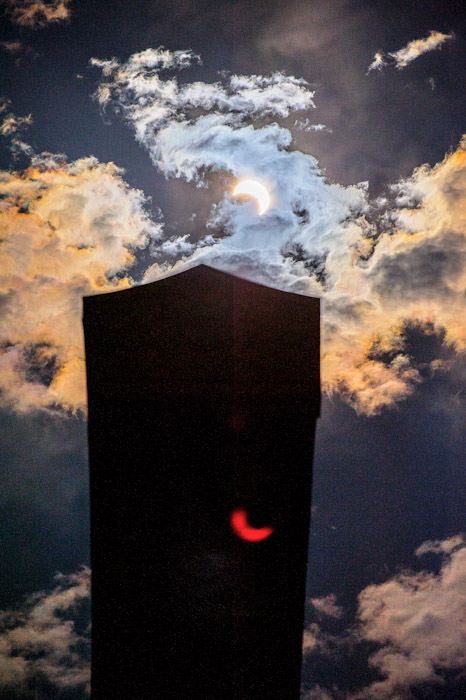
Nikon D700 + Nikkor 70-200mm f/2.8 @ 200mm — 1/250 sec, f/6.3, ISO 1000 — map & image data — nearby photos
Where
is my green “ghost”?
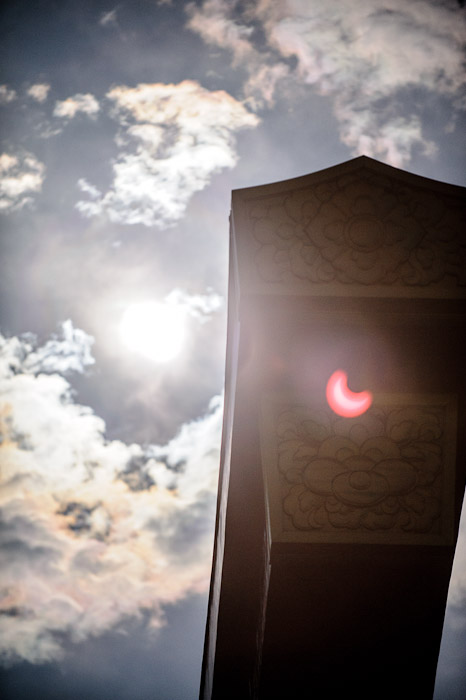
Nikon D700 + Nikkor 70-200mm f/2.8 @ 200mm — 1/80 sec, f/2.8, ISO 1000 — map & image data — nearby photos
A Bit Of Detail
in the shadows on this one
at the expense of the sun and “ghost” blowing out even further
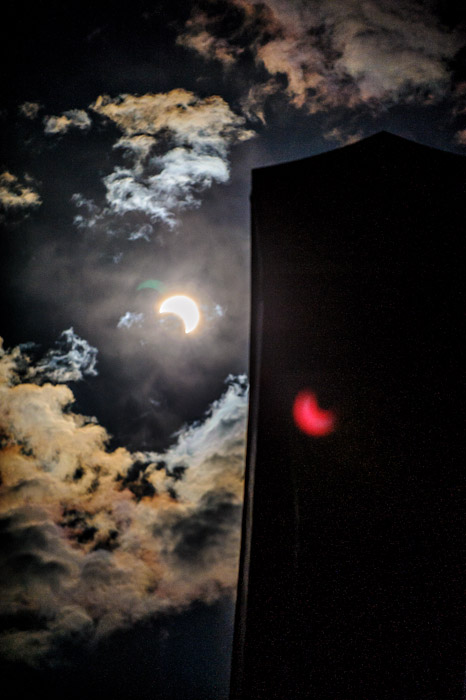
Nikon D700 + Nikkor 70-200mm f/2.8 @ 200mm — 1/800 sec, f/2.8, ISO 1000 — map & image data — nearby photos
Less Blowout
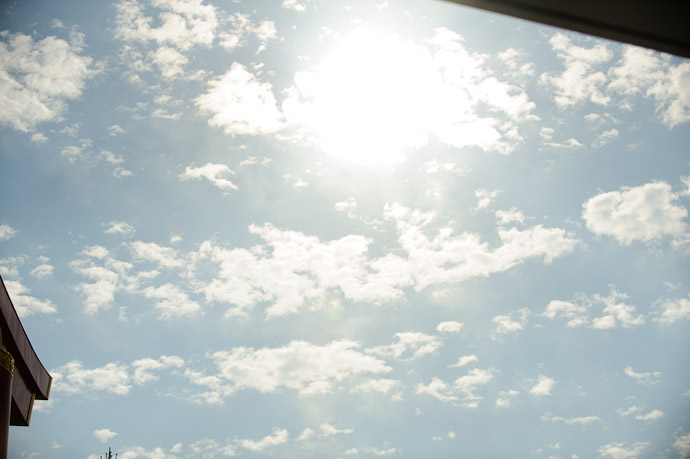
Nikon D700 + Nikkor 70-200mm f/2.8 @ 70mm — 1/8000 sec, f/5, ISO 1000 — map & image data — nearby photos
No Filters
but still needed a zippy 1/8,000th of a second to get even this
Thanks for posting these views. At our location in California we were able to see the way that sunlight coming through trees cast crescent-shaped highlights (at the peak of the eclipse). We are about 200 miles off of the “full eclipse” track. Tom
Regarding the dynamic range of a partial eclipse:
German Wikipedia has the sun at 300000 to 400000 times the brightness of the full moon and the earthshine on the “dark” side of the moon at 0.01% of the full moon. Both sun and moon have approx. the same apparent “area” seen from Earth. That makes the moon in front of the sun about 0.00000000025 to 0.00000000033 times the brightness of the sun – roughly 31.5 to 32 stops, I think. Maybe just this once HDR is justified 😉
(Btw., that also explains nicely why it wasn’t dark – the 1/16th sun still beats 20000 full moons…)
Wish I had proper equipment for this… what/how many filters were you using? I had what I had to hand, stacked +2, +4 and +8 ND filters of a size too small for my 400mm lens, manually set the camera to f/40, 1/8000, ISO 100… and still had to turn down exposure in LR to get a “clear” image.
I attempted (as I do with practically every eclipse, solar or lunar, that I’m fortunate to see) to do a time-lapse, snapping a photo every minute. But, as usual I didn’t have my tripod so it was hand held… and I now come to find out with 88 photos to merge that Photoshop won’t auto-align… “not enough overlap” 🙁 Oh well, in a year or two I’ll get around to manually aligning all of them together. In the meantime, just two will have to do. http://www.flickr.com/photos/eaglekepr/7255320222/
For the 300mm I had a 1/100,000th solar filter ($60 or so from amazon.co.jp), and for the 70-200 I stacked 8-stop and 3-stop filters that I had lying around. —Jeffrey
I could look at the annular eclipse through a infrared R72 filter. Was the correct protection for my eyes, and I could see the eclipse very well in Los Angeles Area. I had the bright idea to photograph using Ilford SFX200 film, at various exposure settings. The film is infrared sensitive film. Processed the film got wonderful photographs of the sun but no eclipse. Congratulations on your photographs, the moral of my experiment, do not use IR film!
Hi
some of the pictures have ISO 1000 in the line below… Is that a typo?
Some pretty cool pictures!
Not a typo. The full solar filter makes even the sun a bit dark, and since I was doing some of these handheld, I wanted a fast-enough sensor. On the D700 ISO 1,000 is very clean, so I picked that and went with it for the day. —Jeffrey